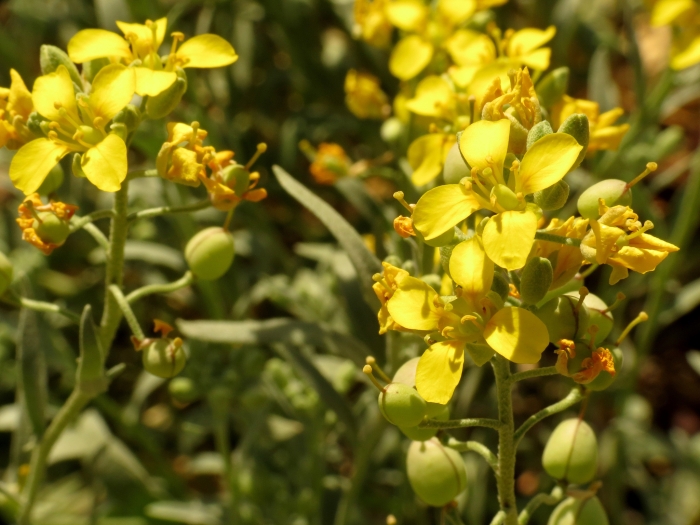Gordon’s Bladderpod
(Physaria gordonii)
Gordon’s Bladderpod (Physaria gordonii)
/
/

Katja Schulz
CC BY 4.0
Image By:
Katja Schulz
Recorded By:
Copyright:
CC BY 4.0
Copyright Notice:
Photo by: Katja Schulz | License Type: CC BY 4.0 | License URL: http://creativecommons.org/licenses/by/4.0/ | Rights Holder: Katja Schulz | Publisher: iNaturalist | Date Created: 2016-02-20T15:00:42-08:00 |



















































Estimated Native Range
Summary
Physaria gordonii, commonly known as Gordon’s Bladderpod, is a semi-deciduous plant that can behave as an annual, biennial, or perennial herb, depending on environmental conditions. It is native to the arid and semi-arid regions, including deserts, grasslands, and scrublands of the South Central United States and Mexico. This species is particularly adapted to sandy or gravelly soils in its native habitat, where it contributes to the biodiversity of desert and grassland ecosystems.
Gordon’s Bladderpod is a winter annual wildflower that typically matures between April and June. It features low-growing stems and long, lanceolate leaves that measure approximately 4 inches (10 cm) in length. The plant’s flowers are arranged in a loose, raceme cluster and are radially symmetrical, showcasing a bright yellow hue that can add a splash of color to gardens. The flowers are moderately showy, attracting pollinators such as bees. In cultivation, it is valued for its drought tolerance and ability to thrive in challenging conditions, making it suitable for xeriscaping and rock gardens. It generally does best in full sun or part shade and requires medium amounts of water, preferring soils with fast drainage. While not commonly used, it can serve as an interesting addition to native plant gardens or as part of a pollinator-friendly planting scheme.CC BY-SA 4.0
Gordon’s Bladderpod is a winter annual wildflower that typically matures between April and June. It features low-growing stems and long, lanceolate leaves that measure approximately 4 inches (10 cm) in length. The plant’s flowers are arranged in a loose, raceme cluster and are radially symmetrical, showcasing a bright yellow hue that can add a splash of color to gardens. The flowers are moderately showy, attracting pollinators such as bees. In cultivation, it is valued for its drought tolerance and ability to thrive in challenging conditions, making it suitable for xeriscaping and rock gardens. It generally does best in full sun or part shade and requires medium amounts of water, preferring soils with fast drainage. While not commonly used, it can serve as an interesting addition to native plant gardens or as part of a pollinator-friendly planting scheme.CC BY-SA 4.0
Plant Description
- Plant Type: Herb
- Height: 0.3-1.3 feet
- Width: 0.3-1.2 feet
- Growth Rate: Moderate
- Flower Color: Yellow
- Flowering Season: Spring, Summer
- Leaf Retention: Semi-Deciduous
Growth Requirements
- Sun: Full Sun, Part Shade
- Water: Medium
- Drainage: Fast
Common Uses
Bee Garden, Butterfly Garden, Low Maintenance, Showy Flowers
Natural Habitat
Native to arid and semi-arid regions, including deserts, grasslands, and scrublands of the South Central United States and Mexico
Other Names
Common Names:
Scientific Names: , Lesquerella gordonii, Physaria gordonii, Lesquerella gordonii var. densifolia, Lesquerella gordonii var. gordonii, Physaria gordonii subsp. gordonii, Vesicaria gordonii, Alyssum gordonii, Physaria gordonii subsp. densifolia, Physaria gordonii var. densifolia,
GBIF Accepted Name: Physaria gordonii (A.Gray) O’Kane & Al-Shehbaz